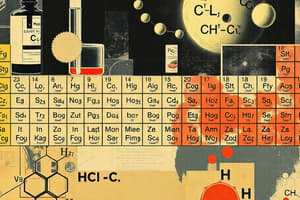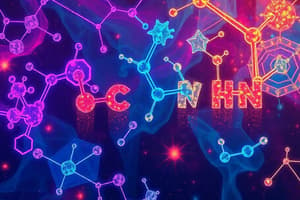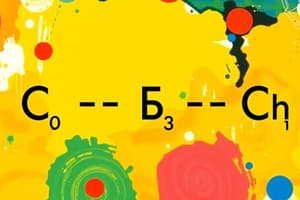Podcast
Questions and Answers
What is the defining characteristic of a molecular compound?
What is the defining characteristic of a molecular compound?
- It has a high melting point.
- It consists of cations and anions.
- It is made by joining nonmetal atoms together. (correct)
- It forms a crystal lattice structure.
Which option correctly describes cations?
Which option correctly describes cations?
- They are negative ions formed by gaining electrons.
- They are only found in molecular compounds.
- They have more protons than electrons and are formed by losing electrons. (correct)
- They are neutral atoms with an equal number of protons and electrons.
Which of the following groups contains all metals?
Which of the following groups contains all metals?
- Group 5A
- Group 7A
- Group 6A
- Group 1A (correct)
What property distinguishes metalloids from metals and nonmetals?
What property distinguishes metalloids from metals and nonmetals?
What happens when an atom gains electrons?
What happens when an atom gains electrons?
What type of compound is formed primarily by the interaction between metals and nonmetals?
What type of compound is formed primarily by the interaction between metals and nonmetals?
Which of the following statements about ionic compounds is true?
Which of the following statements about ionic compounds is true?
What characteristic is generally true for metallic elements?
What characteristic is generally true for metallic elements?
Flashcards
Compound
Compound
A substance made up of two or more different elements chemically combined in a fixed ratio.
IUPAC Naming
IUPAC Naming
A systematic way of naming chemical compounds that uses a set of rules.
Group
Group
A group of elements in the periodic table that share similar properties.
Metals
Metals
Signup and view all the flashcards
Nonmetals
Nonmetals
Signup and view all the flashcards
Metalloids
Metalloids
Signup and view all the flashcards
Anion
Anion
Signup and view all the flashcards
Cation
Cation
Signup and view all the flashcards
Study Notes
Naming Compounds and Writing Formulas
- Compounds are made of two or more elements.
- Systematic naming (IUPAC) is necessary due to the vast number of compounds.
- Compound names should indicate the number and type of atoms present in the compound.
Periodic Table
- The periodic table organizes elements by similar properties.
- Elements are arranged in columns called groups.
- Group A elements are representative elements.
Metals
- Metals are typically shiny (luster).
- Metals are ductile (can be drawn into wires).
- Metals are malleable (can be hammered into sheets).
- Metals are conductors of heat and electricity.
Transition Metals
- Transition metals are Group B elements.
- Transition metals can have various charges.
Non-metals
- Non-metals are typically dull.
- Non-metals are brittle.
- Non-metals are nonconductors/insulators.
Metalloids/Semimetals
- Metalloids exhibit properties of both metals and non-metals.
- Metalloids are semiconductors.
Atoms and Ions
- Atoms are electrically neutral (equal number of protons and electrons).
- Ions are atoms (or groups of atoms) with a charge.
- Ions form when the number of protons and electrons are not equal due to the gain or loss of electrons.
Anions
- Anions are negatively charged ions.
- Anions are formed when atoms gain electrons.
- Name of anion ends in -ide (e.g., Fluoride).
Cations
- Cations are positively charged ions.
- Cations are formed when atoms lose electrons.
- Name of cation is the same as the name of the element (e.g., Sodium).
Compounds
- Compounds follow the Law of Definite Proportion, meaning their composition is consistent.
- Compounds must have the same number of atoms each time they are created.
- There are two main types of compounds: Molecular Compounds and Ionic Compounds.
Molecular Compounds
- Molecular compounds are made of molecules. These are made from combining non-metals.
- The smallest piece of a molecular compound is a molecule.
Ionic Compounds
- Ionic compounds are made of cations and anions.
- Ionic compounds consist of metals and non-metals.
- Electrons lost by the cation are gained by the anion.
- The smallest piece of an ionic compound is a formula unit.
Chemical Formulas
- Chemical formulas show the number and type of atoms in a substance.
- Molecular formulas show the atoms in a molecule.
Formula Unit
- The formula unit represents the smallest whole-number ratio of atoms in an ionic compound.
Charges on Ions
- The periodic table helps predict the charge of Group A elements.
- Elements in the same group have similar properties, including ion charges.
Naming Ions
- Group A elements, the charge is predictable.
- Transition metals require their charge to be explicitly indicated using Roman numerals in parentheses (e.g., copper(II)).
Naming Anions
- The name of an anion usually changes to end with -ide.
Writing Formulas for Compounds
- Charges of different ions/polyatomic must balance out to zero.
- Write the symbol and subscripts to balance the charges.
Naming Binary Ionic Compounds
- Binary ionic compounds contain two elements. - Name the cation, and then the anion in a singular sentence.
- The ionic compound must be neutral (have an overall charge of 0).
- Use the anion to determine the charge of the cation
Naming Ternary Ionic Compounds
- Ternary ionic compounds consist of three or more elements.
- Ternary Ionic compounds contain polyatomic ions.
- Name the cation and then the anion.
Naming Acids
- Acids are compounds that produce hydrogen ions when dissolved in water.
- Acids must contain hydrogen (H).
- If the anion in the acid ends in -ide, the acid name will begin with hydro- and end in -ic acid.
- If the anion ends in -ate, change it to -ic acid.
- If the anion ends in -ite, change it to -ous acid.
Writing Formulas for Acids
- The name of the acid tells you the type of anion.
- Charges of the different ions must balance out to zero.
Studying That Suits You
Use AI to generate personalized quizzes and flashcards to suit your learning preferences.




